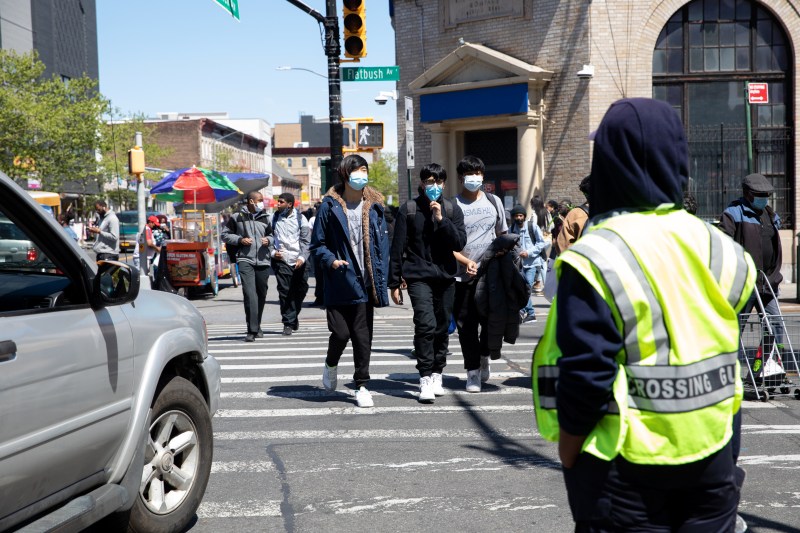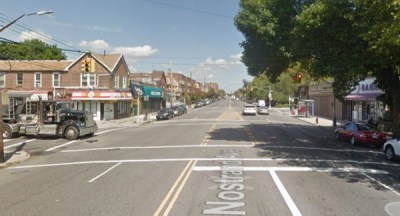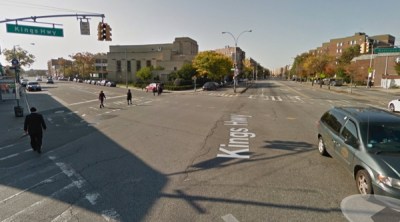Nearly 500 Crossing Guard Positions, Rather than Being Filled, Are Cut By Mayor Adams and NYPD

Safety last.
The NYPD has cut close to 500 crossing guard positions in a money-saving measure — a move that puts kids at risk on school roadways that were already more dangerous than other city streets.

As first reported on Thursday by the Daily News, NYPD Chief of Patrol John Chell ordered an “18-percent overall reduction” in the school street safety personnel from every borough command by June 2, according to a memo obtained by the paper. “The part-time authorized headcount for school crossing guards has been reduced by 483 positions in FY 2024 with a new authorized headcount of 2,219.”
A spokesperson for City Hall disputed the Daily News story, and deferred to the NYPD — which then confirmed the substance of the story: 483 positions had, indeed, been eliminated. Those positions were vacant, so no current crossing guard lost his or her job. Those 483 positions came from a pool of 600 vacant positions in the ranks of crossing guards, the agency said.
The overall number of crossing guards already is down from more than 3,000 in fiscal year 2019 and even if the remaining 117 vacancies are filled, there will still be more than 700 fewer crossing guards. The cuts will save $7.5 million from the $43-million crossing guard budget, according to the NYPD.
The move comes despite evidence that school streets are significantly more dangerous than the rest of the roadways in town. As Streetsblog reported in an award-winning investigation last year, on school days, there are 57 percent more crashes and 25 percent more injuries per mile on streets near schools than on the city’s other streets. This disparity largely disappears on days when schools are closed.
In addition, streets are especially dangerous outside schools where most students are poor or children of color. In the 2019 school year, for example, the rate of people injured by drivers on school days was 43 percent higher outside school buildings where a majority of students were brown or Black than outside school buildings with majority-white students.
NYPD is moving to cut its school crossing guard ranks by 18%, and sources tell us that will result in firings — seemingly running counter to Mayor Adams' vow to not base savings on layoffs.
"It’s going to be a disaster," one guard said.
w/ @Tomtracyv https://t.co/GmRlOV07pn
— Chris Sommerfeldt (@C_Sommerfeldt) May 25, 2023
Drivers crash nearly 50 times and injure a dozen people near city public schools during the average day when schools are open. That’s a crash every 29 minutes and an injury every two hours. Drivers killed at least 24 children heading to or from school between 2012 and 2022.
The roads are dangerous to crossing guards themselves, with scores of guards being injured, too.
“People don’t want the job,” said Denise Ferrante, school crossing guards chair for Local 372, which represents the guards and other school workers. “They don’t want to risk their lives.”
The crossing guard union itself blamed a succession of failed city leaders.
“Administration after administration has neglected this area,” said Donald Nesbit, the executive vice president of Local 372. (A call to the union’s president, Shaun Francois, was not returned on Thursday.)
Interviews with current and former guards painted a picture of grueling, dangerous work. The guards, mostly women of color, said they have been spit on, cursed at and threatened by drivers. Nearly all said they have been almost hit by drivers. Leaders of the union that represent the guards estimated that ten of them have been injured by drivers since 2014. At least two city crossing guards have been killed on the job by drivers.
For their troubles, the guards receive a little over minimum wage, plus health care.
Where the city fails to make streets safe, it sends crossing guards out to make up the difference. Their tools: a uniform, a whistle, a willingness to put their bodies between children and multi-ton vehicles and the hope, however optimistic, that drivers will yield.
The NYPD declined to make Chell available for an interview. The agency issued the following statement, attributed to a “spokesperson”:
This year’s executive budget for the School Crossing Guard position was reduced by eliminating vacant positions. At that time, there were 600 part-time vacancies in the School Crossing Guard position. That count was reduced by 483 positons. But that budgetary maneuver did not amount to layoffs, as no active positons were eliminated. Vacancies are fluid in fiscal planning, and the NYPD remains committed to actively recruiting and hiring additional School Crossing Guards, up to the authorized headcount. Remember, the NYPD works every day to best manage the budget and the operational needs of its public safety mission.
A spokesperson for City Hall did not respond to specific questions about the cuts, including how reducing safety agents is justified under Vision Zero. (Update: But after initial publication of this story, a spokesperson said that the main short term goal was to reduce the budget allocation by eliminating positions that weren’t even filled. The spokesperson said that if the NYPD decides it needs to fill the remains vacancies or even expand the ranks of crossing guards, the Adams administration will consider it.)
— with Jesse Coburn

